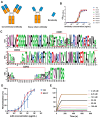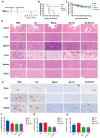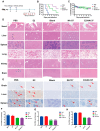Screening of Neutralizing Antibodies Targeting Gc Protein of RVFV
- PMID: 40285002
- PMCID: PMC12031069
- DOI: 10.3390/v17040559
Screening of Neutralizing Antibodies Targeting Gc Protein of RVFV
Abstract
Rift Valley fever virus (RVFV) is a mosquito-transmitted bunyavirus that can cause substantial morbidity and mortality in livestock and humans, for which there are no currently available licensed human therapeutics or vaccines. Therefore, the development of safe and effective antivirals is both necessary and urgent. The Gc protein is the primary target of the neutralizing antibody response related to Rift Valley fever virus. Here, we report one Gc-specific neutralizing antibody (NA137) isolated from an alpaca and one bispecific antibody (E2-NA137), the protective efficacies of which we evaluated in A129 mice. In this prophylactic study, the survival rates of the NA137 and E2-NA137 groups were both 80%, and in the treatment study, the survival rates were 20% and 60%, respectively. Altogether, our results emphasize that NA137 and E2-NA137 provide a potential approach for treating RVFV either prophylactically or therapeutically.
Keywords: Gc protein; Rift Valley fever virus (RVFV); VHH; bispecific antibody (bsAb); nanobody (Nb); neutralizing antibody (NAb).
Conflict of interest statement
The authors declare no conflicts of interest.
Figures






Similar articles
-
A Novel BoHV-1-Vectored Subunit RVFV Vaccine Induces a Robust Humoral and Cell-Mediated Immune Response Against Rift Valley Fever in Sheep.Viruses. 2025 Feb 23;17(3):304. doi: 10.3390/v17030304. Viruses. 2025. PMID: 40143235 Free PMC article.
-
Potent neutralizing human monoclonal antibodies protect from Rift Valley fever encephalitis.JCI Insight. 2024 Aug 1;9(18):e180151. doi: 10.1172/jci.insight.180151. JCI Insight. 2024. PMID: 39088277 Free PMC article.
-
Novel replication-competent reporter-expressing Rift Valley fever viruses for molecular studies.J Virol. 2025 Jan 31;99(1):e0178224. doi: 10.1128/jvi.01782-24. Epub 2024 Dec 12. J Virol. 2025. PMID: 39665546 Free PMC article.
-
Recent advances in treatment and detection of Rift Valley fever virus: a comprehensive overview.Virus Genes. 2025 Aug;61(4):400-411. doi: 10.1007/s11262-025-02164-0. Epub 2025 May 10. Virus Genes. 2025. PMID: 40348846 Review.
-
Has the epidemiologic conundrum of Rift Valley fever changed?Trop Anim Health Prod. 2025 Jun 30;57(6):292. doi: 10.1007/s11250-025-04531-3. Trop Anim Health Prod. 2025. PMID: 40586979 Review.
References
-
- Bird B.H., Githinji J.W., Macharia J.M., Kasiiti J.L., Muriithi R.M., Gacheru S.G., Musaa J.O., Towner J.S., Reeder S.A., Oliver J.B., et al. Multiple virus lineages sharing recent common ancestry were associated with a Large Rift Valley fever outbreak among livestock in Kenya during 2006–2007. J. Virol. 2008;82:11152–11166. doi: 10.1128/JVI.01519-08. - DOI - PMC - PubMed
MeSH terms
Substances
Associated data
- Actions
LinkOut - more resources
Full Text Sources
Miscellaneous

